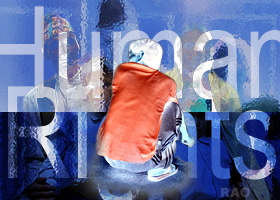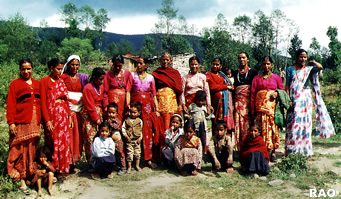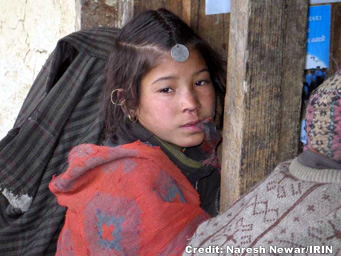|
Nepal
in Crisis 2006: Facts |
|
Violence
against Women during Armed Conflict |
 |
Bidhya
Chapagain, June 9 , 2006
 |
| Violence
against women is not accidental. It is a weapon of war, a tool used to
achieve military objectives such as ethnic cleansing, spreading political
terror, breaking the resistance of a community, intimidation or to extract
information. It has been investigated that, in conflict situation, the
targeting of victims and the forms of the abuse carried out during armed
conflict were based on gender as well as other identity, such as ethnicity
or race. The abuse of women in armed conflict is rooted in a global culture
of discrimination that denies women equal status with men. |
|
Social,
Political and religious norms identify women as the property of men, conflate
women's chastity with family honor and ethnic identity, and legitimize
the violence appropriate of women's bodies for individual gratification
or political ends.
| "Gender-based
violence" |
 |
General
recommendation No. 19 of the UN Committee on the Elimination of All Forms
of Discrimination Against Women (CEDAW), asserts "gender-based violence"
is violence that is directed against a women because she is a women or
(because violence) affects women disproportionately - "therefore, women
who experience infringement upon their human rights due to armed conflict
are not under an equal protection of the law."
Violence
against women in Nepal's conflict presents evidence of the horrific scenario
during the war. Throughout the armed conflict in Nepal, thousands of women
and girls of all ages were subjected to widespread and systematic violence.
Nepal's ten years long conflict has been marked by an extraordinary level
of brutal human rights abuses, including violence against women. While
armed conflict affects women in a number of forms that are conflict specific,
certain trends are prevalent across conflicts. It is important to note
that most women suffer the impacts of war in multiple ways:
Rape
Trafficking
and sexual slavery
Displacement
Economic
hardship |
Among
all above listed impacts on women, sexual violence and rape is being used
deliberately and strategically as weapon of war.
 |
The
consequences for victims of sexual violence in war are grave and may affect
women for the rest of their lives. These includes serious and chronic medical
problems, psychological damage, life-threatening diseases such as HIV/AIDS,
forced pregnancy, infertility, stigmatization and rejection by family members
and communities. |
|
The
jurisprudence of the international criminal Tribunal for Rwanda recognizes
rape and other forms of sexual violence by combatants in the conduct of
armed conflict as war crimes. When rape and sexual violence are committed
as part of a widespread or systematic attack directed against any civilian
population, they are considered crimes against humanity and in some cases
may constitute an element of genocide. Although rape as a weapon of war
violates the Geneva Conventions and is identified as a war crime, women
continue to be raped in modern day conflicts. Sexual violence during wartime
is often directly linked to armed groups, military, guerrilla, fighters.
The lack of law enforcement in war Zones is exploited by civilians, sex
traffickers, or international peacekeepers looking for amusement, opportunities
or revenge.
Article
27 of the 1949 Geneva Convention, in responses to the aggressive reprisal
upon women during World War II, states, "women shall be especially protected
against any attack on their honor, in particular against rape, enforced
prostitution, or any form or indecent assault." It further denounces these
actions based upon nationality, race, religious beliefs, age, marital status
or social condition." Common article 3 of the 1949 Geneva Conventions,
addressing cases of non-international armed conflict, prohibits acts against
non-combatants including "murder of all kinds", "violence to life and person",
torture, the taking hostages, and outrages upon personal dignity, in particular
humiliating and degrading treatment.
Protocol
I of the 1949 Geneva Conventions, addressing civilian and/or military authorities
who involved themselves in cases of international armed conflict as well
as colonial domination and racist regimes, states women "shall be protected
in particular against rape, forced prostitution and any form of indecent
assault."
Many
victims of gender based violence during armed conflict are reluctant to
talk about their suffering.
 |
| Pressure from warring parties of the conflict,
the government, the family or community all serve to intimidate many women
into silence. Continuing violence or conflict often prevents women from
reporting. In many regions reprisal, shame and social stigma are attached
to certain types of violence against women, particularly rape. Fear of
the consequences of reporting sexual violence, such as facing rejection,
alienation, divorce, being declared unfit for marriage and severe economic
and social repercussion all discourage women from reporting the violence
suffered. |
|
Legal
mechanisms for women's protection in wartime are in place. The government
should be made accountable for implementing the provisions and ensuring
women's human rights are respected during the times of armed conflict.
Supporting the victims of sexual violence is very important. The government
should strengthen the capacity of police force and judicial system adequately
to address cases of sexual violence including rape and should work with
the organisations and experts to establish gender-based violence reporting
procedures that are effective, sensitive, and that protect victims. The
government should ensure that efforts are made to coordinate the various
actors providing treatment to those who have suffered sexual violence.
The government and other INGOs and NGOs should support effective and culturally
appropriate psychological programs for those who suffered sexual violence
and ensure that women are included in all aspects of planning for peace,
demobilization, reintegration and rebuilding and support local organisations
working to promote women's full participation and rights.
 |
| Credit Informal
Sector Service Centre (INSEC), Opinion Forum 2006 |
| more information |
 |
| Links |
 |
 |
 |
External
Links |
|






